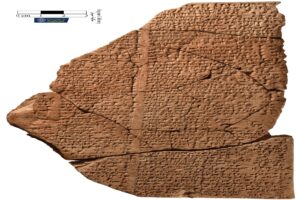When workers on a British road improvement project excavated a nondescript skeleton buried alone, it might have raised some eyebrows.
But it didn’t pull the same weight among the archaeologists who finished the job — until they applied high-tech tools.
Offord Cluny 203645 was a complete, well-preserved male skeleton, buried without any personal effects in a Cambridgeshire ditch. A team led by the Francis Crick Institute could tell the remains were clearly ancient. But with no contextual clues to go on, they might have hit a dead end.
Updated forensic technology intervened, and provided the first biological proof of a certain, far-flung immigration pattern during the Roman Empire.
The man was a Sarmatian, and the team’s tests proved he made it from his homeland in what is now the southern Russia/Ukraine area to his final destination in the United Kingdom.

Image: Francis Crick Institute
The mystery’s man’s long trek
It’s a journey of about 2,400 kilometers, and he likely did it as a Roman cavalry soldier or servant.
How did the researchers find out?
First, they extracted DNA from a tiny bone in his inner ear. This turned out to be his best-preserved body part containing the most complete DNA samples. Dr. Marina Silva, of the Ancient Genomics Laboratory at the Francis Crick Institute, extracted and analyzed the samples for the study.
“This is not like testing the DNA of someone alive,” Silva told The BBC. “The DNA is very fragmented and damaged. However, we were able to [decode] enough of it. The first thing we saw was that genetically he was very different” from the Romano-British individuals they’d previously studied.
Sarmatians were nomads, distinguished by their horsemanship and their Iranian mother tongue. They were especially active during the first several centuries AD, which is when Offord Cluny died — his grave dates to about 126-228 AD.
Historical records show that he could have been the son or slave of a cavalry soldier, The BBC reported. During his lifetime, a unit of the Sarmatian cavalry joined the Roman army and deployed to the UK.
New sleuthing techniques
That still didn’t connect the dots, though. How could the scientists prove that he was born in Eurasia and immigrated to the place of his death?
For this, they examined his teeth. Even two millennia after his death, the tissue harbored chemicals in varying amounts at different layers. Offord Cluny underwent pronounced dietary changes at ages 5 and 9 and began to level out around 13.

Offord Cluny 203645. Photo: MOLA Headland Infrastructure
The changes, the team found, followed chemical trends you could expect from a person adapting to available food sources while traveling west across Europe.
Millets and sorghum grains, scientifically called C4 crops, are plentiful in the region where Sarmatians lived. These dissipated in his diet as he matured. Wheat — more common in Western Europe — replaced them.
“The [analysis] tells us that he, and not his ancestors, made the journey to Britain. As he grew up, he migrated west, and these plants disappeared from his diet,” said Janet Montgomery of Durham University.
In the end, it’s still a story about an inconsequential person undergoing a migration he probably influenced very little. What’s the takeaway?
Well, if you ever want to cover your tracks: Don’t leave your teeth or your ear canals where any archaeologists can find them.






